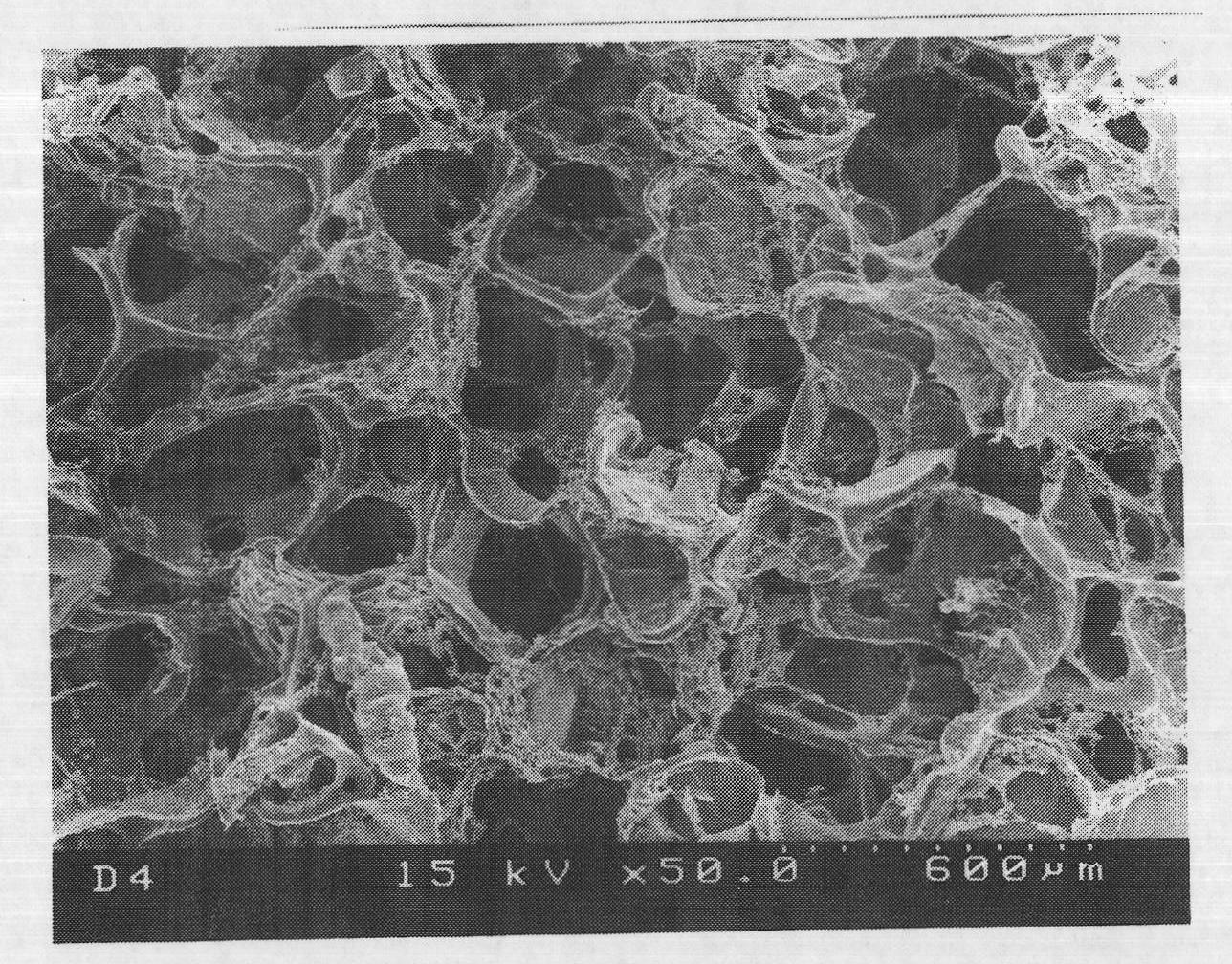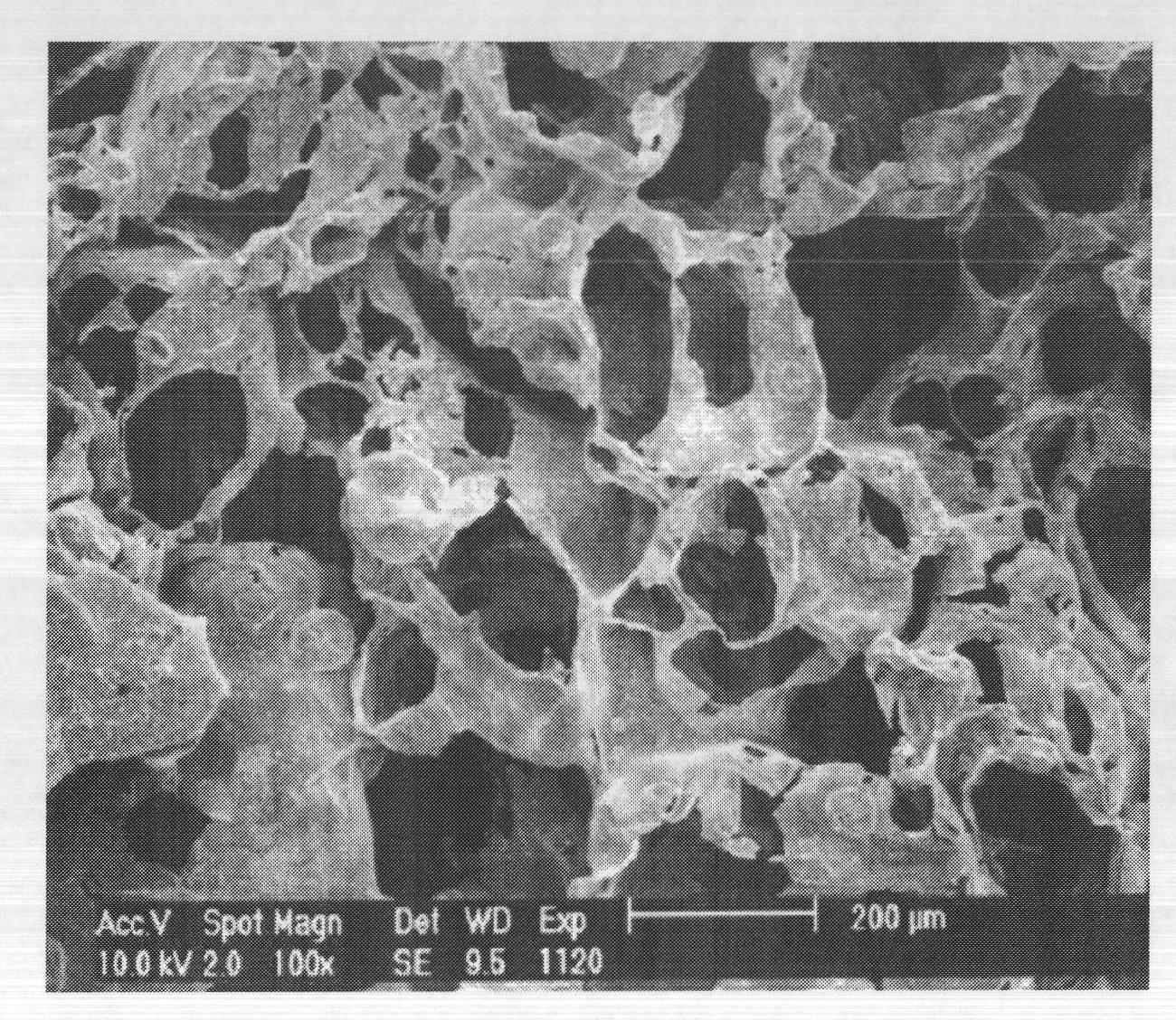Porous biodegradable stent and preparation method thereof
A biodegradable and biodegradable technology, applied in the field of porous biodegradable scaffolds and their preparation, can solve problems such as failure to realize commercialization, and achieve a non-immune rejection, high continuity, and good biodegradability. Effect
- Summary
- Abstract
- Description
- Claims
- Application Information
AI Technical Summary
Problems solved by technology
Method used
Image
Examples
Embodiment 1
[0039] (1) At room temperature, dissolve PLGA (75PLA:25PGA) with a molecular weight of 5000 (75PLA:25PGA) at a weight percentage of 20:80 in an organic solvent prepared from dichloromethane for 2 hours to form a highly viscous solution;
[0040] (2) Add sodium chloride according to the weight ratio of sodium chloride to biodegradable polymer at 1:5, stir uniformly at room temperature, and mix and stir for 1 minute to form biodegradable polymer, organic solvent and chlorine Then quickly fill the paste mixture into a plastic mold and press 345 kPa for 10 minutes to form a semi-finished product;
[0041] (3) Dry the semi-finished product at 29°C for 24 hours to remove the organic solvent to form a molded product;
[0042] (4) Use purified water to continuously remove sodium chloride from the molded product for 30 hours, resulting in a sodium chloride concentration of less than 3 μg / ml;
[0043] (5) After removing sodium chloride, put the molded product into an ultra-low temperature stora...
Embodiment 2
[0046] (1) At room temperature, dissolve PLGA (65PLA:35PGA) with a molecular weight of 200,000 at a weight percentage of 30:70 in an organic solvent prepared from dichloromethane and acetone at a weight percentage of 50:50 for 2.5 hours to form a high Viscous solution
[0047] (2) Add potassium chloride according to the weight ratio of potassium chloride to biodegradable polymer at 1:10, stir uniformly at room temperature, and mix and stir for 2 minutes to form biodegradable polymer, organic solvent and chlorine The paste mixture of potassium sulfide is then quickly filled into the plastic mold and pressed at 414 kPa for 9 minutes to form a semi-finished product;
[0048] (3) Dry the semi-finished product at 28°C for 30 hours to remove the organic solvent to form a molded product;
[0049] (4) Use purified water to continuously remove potassium chloride from the molded product for 24 hours, resulting in a potassium chloride concentration of less than 3 μg / ml;
[0050] (5) After remov...
Embodiment 3
[0053] (1) At room temperature, dissolve PLGA (50PLA:50PGA) with a molecular weight of 350,000 at a weight percentage of 35:65 in an organic solvent prepared from acetone for 3 hours to form a highly viscous solution;
[0054] (2) Add potassium nitrate according to the weight ratio of potassium nitrate to biodegradable polymer at 1:15, stir uniformly at room temperature, and mix and stir for 2 minutes to form a biodegradable polymer, organic solvent and potassium nitrate Paste mixture, then quickly fill the paste mixture into a plastic mold, press 483 kPa for 8 minutes to form a semi-finished product;
[0055] (3) Dry the semi-finished product at 27°C for 35 hours to remove the organic solvent to form a molded product;
[0056] (4) Use purified water to continuously remove potassium nitrate from the molded product for 48 hours, resulting in a potassium nitrate concentration of less than 3 μg / ml;
[0057] (5) After removing potassium nitrate, put the molded product into an ultra-low te...
PUM
| Property | Measurement | Unit |
|---|---|---|
| Size | aaaaa | aaaaa |
Abstract
Description
Claims
Application Information
 Login to View More
Login to View More - R&D
- Intellectual Property
- Life Sciences
- Materials
- Tech Scout
- Unparalleled Data Quality
- Higher Quality Content
- 60% Fewer Hallucinations
Browse by: Latest US Patents, China's latest patents, Technical Efficacy Thesaurus, Application Domain, Technology Topic, Popular Technical Reports.
© 2025 PatSnap. All rights reserved.Legal|Privacy policy|Modern Slavery Act Transparency Statement|Sitemap|About US| Contact US: help@patsnap.com



